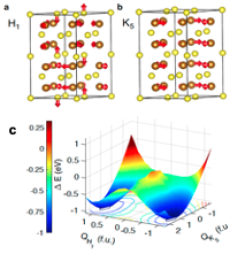Designing Materials with Tunable Electrical and Magnetic Behaviors
Science Highlight
April 13, 2020
Science Achievement
For the first time, the coupling of magnetic spins and atomic dynamics has been fully described in hexagonal iron sulfide (h-FeS), explaining the origin of its fascinating coexistence of metal-insulator, structural, and magnetic transitions.
Significance and Impact
This discovery provides a new route to design materials with tunable electrical and magnetic behaviors for possible applications in information storage and processing.
Research Details
The team used inelastic neutron scattering and inelastic x-ray scattering along with first-principles simulations to track evolution of the lattice and spin dynamics across the magnetic and metal-insulator transitions.
Research establishes that the ordering of magnetic spins on Fe atoms destabilizes the vibrations of atoms (H1 and K5 modes in figure), and leads to a structural distortion opening the band gap (insulator phase).
Strongly anharmonic lattice vibrations associated with unstable phonon modes are controlled by magnetic ordering of spins and in turn provide the structural distortion tuning the band-gap. Thus, spin-phonon and electron-phonon couplings are key to enabling the sequence of phase transitions in h-FeS.
The work used HERIX spectrometer at APS sector 30 (ANL), ARCS & SEQUOIA spectrometers at the SNS (ORNL), and about 1 million hours on 512concurrent CPU cores at NERSC.
Related Links
D. Bansal, J. L. Niedziela, S. Calder, T. Lanigan-Atkins, R. Rawl, A. H. Said, D. L. Abernathy, A. I. Kolesnikov, H. Zhou, and O. Delaire, Nature Physics, (2020). DOI: https://doi.org/10.1038/s41567-020-0857-1.
About NERSC and Berkeley Lab
The National Energy Research Scientific Computing Center (NERSC) is a U.S. Department of Energy Office of Science User Facility that serves as the primary high performance computing center for scientific research sponsored by the Office of Science. Located at Lawrence Berkeley National Laboratory, NERSC serves almost 10,000 scientists at national laboratories and universities researching a wide range of problems in climate, fusion energy, materials science, physics, chemistry, computational biology, and other disciplines. Berkeley Lab is a DOE national laboratory located in Berkeley, California. It conducts unclassified scientific research and is managed by the University of California for the U.S. Department of Energy. »Learn more about computing sciences at Berkeley Lab.








